Or: Can you hear the bottles sing?
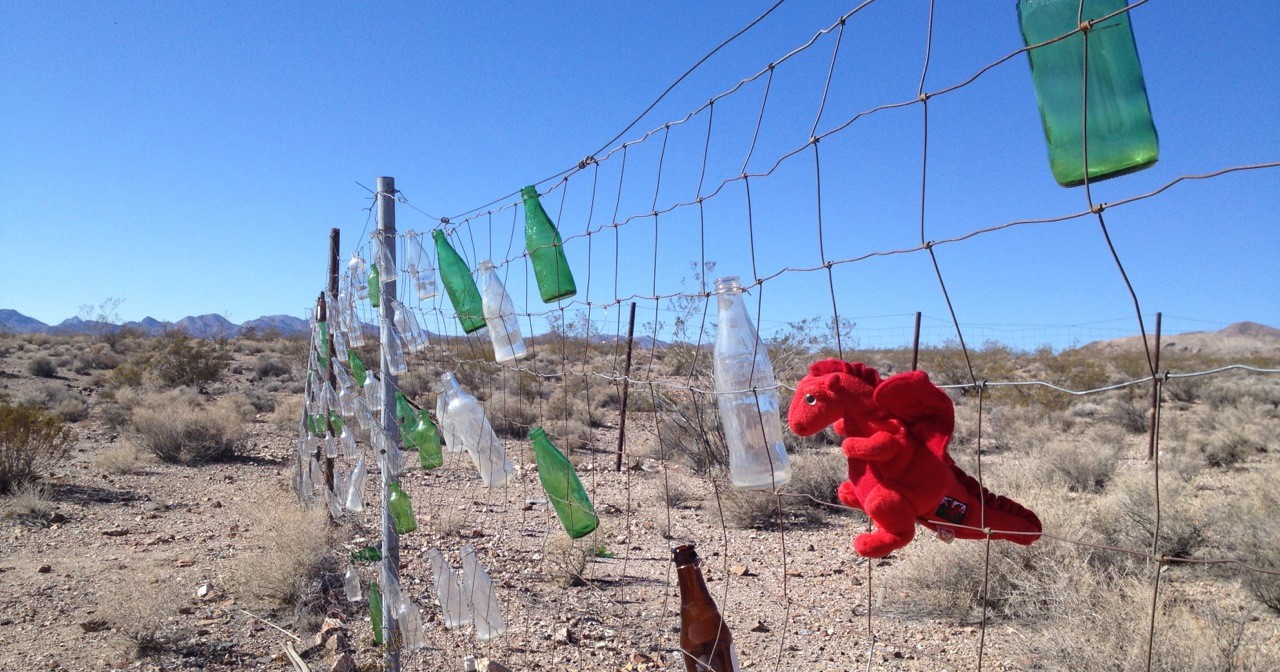
Author’s Note:
This week I am sharing the notes I took on a recent trip to Death Valley National Park with my friend Rose. You can read my report from Day One here, and Day Two here.
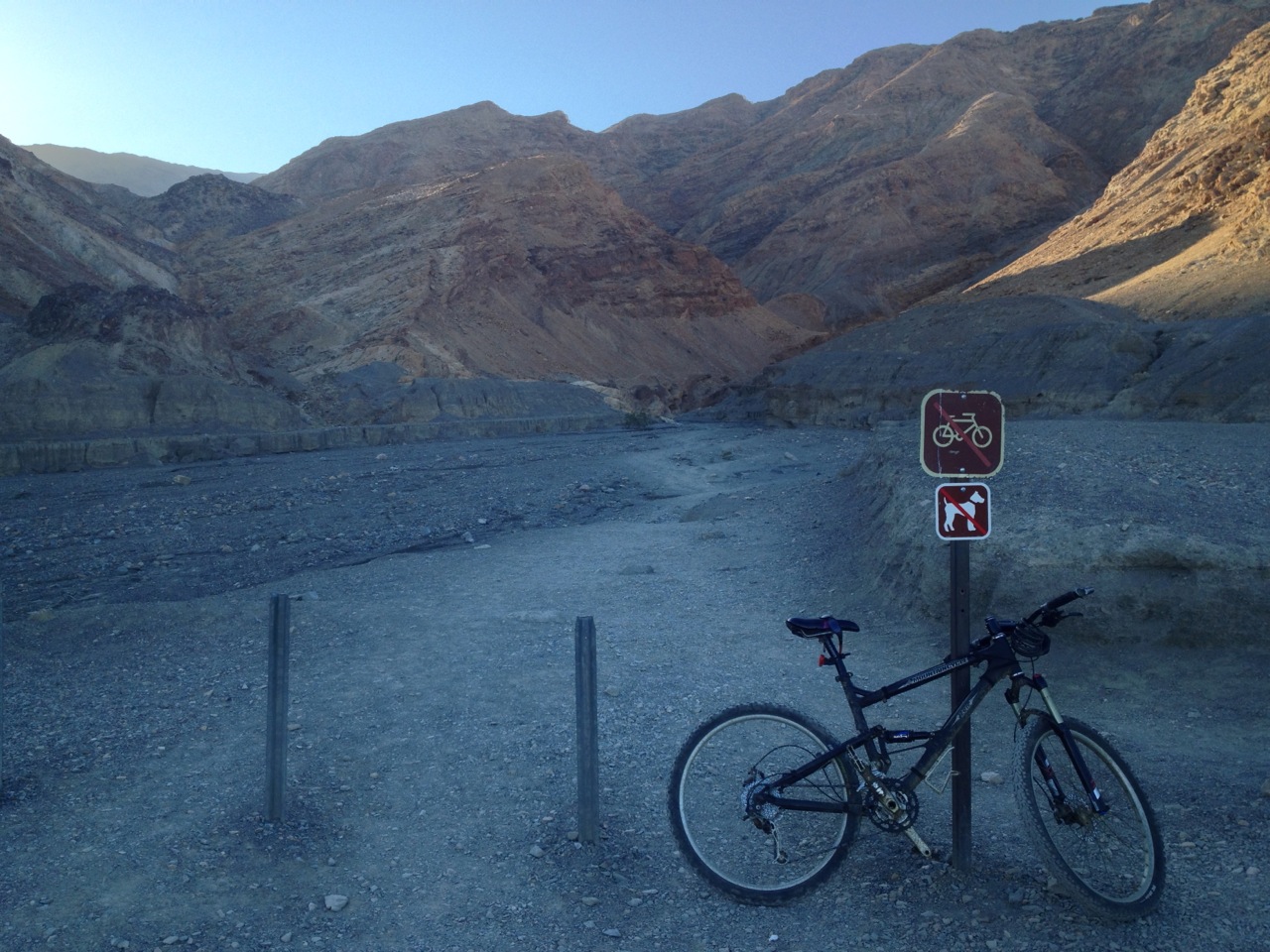
Thursday, February 7 2013
Driving, it seems, is the way to get around Death Valley. To mitigate the effect this has on my brain I determined to go out for a short ride this morning, almost before breakfast. (I say ‘almost’ because I had a snack of kefir and cereal before I left.)
I rode up the two and a half mile gravel road to the head of Mosaic Canyon. It is a deceptively steep rise, and felt longer than it actually took (under forty minutes). I started off cold, so I put on tights and my long-sleeved shirt. Then I got warm riding up the hill in the morning sun, but before I got too hot I passed into the shade of a hill and got cool again. I paused at the top to take some pictures, and then rode down—fast. I knew there was a reason I brought my mountain bike! And even though I did stop a couple of times to take more pictures, I still made it back to the room in fifteen minutes.
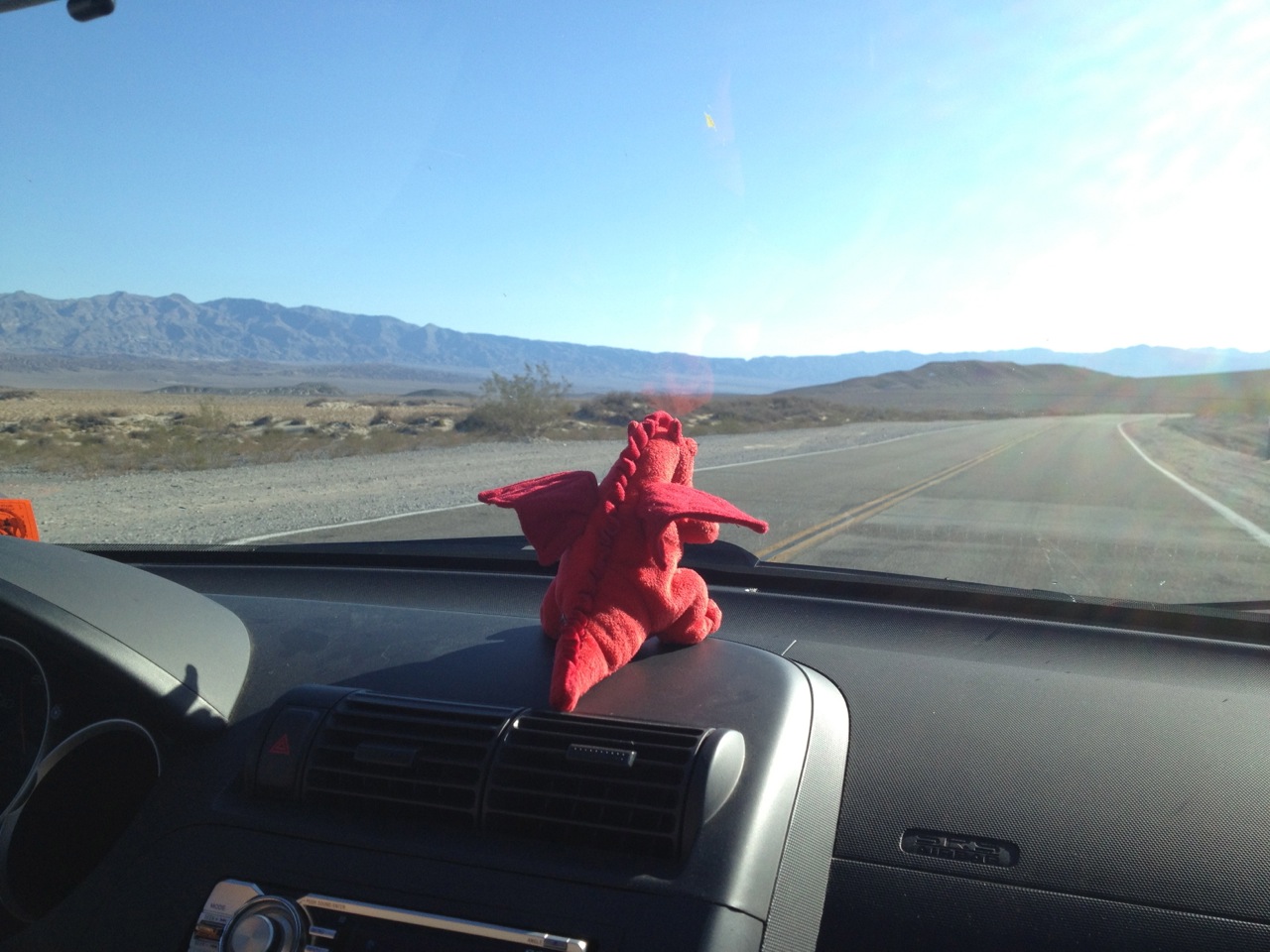
I ate a proper breakfast, showered, and then we packed up some lunch and piled into the car. The plan was to drive the thirty-odd miles east to Beatty, NV, where we could buy fuel for under four dollars a gallon, then drive back and see the ghost town of Rhyolite. I confess I worried (unnecessarily) about getting there on the same tank I’d filled back in Lancaster, almost 300 miles away—but I needn’t have. We made it to Beatty with room to spare, and found a gas station which started at under $3.50. Joy!
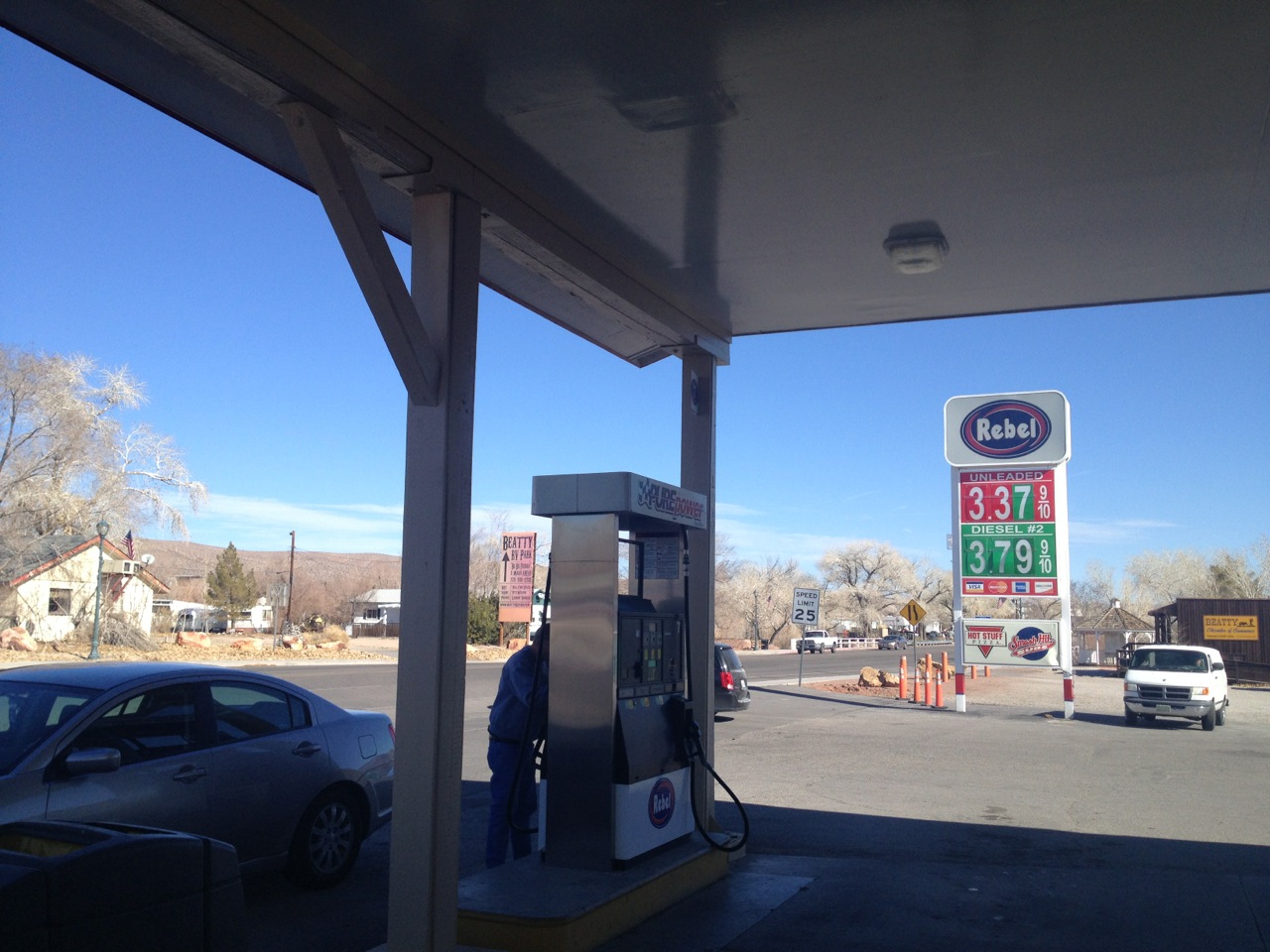
The car successfully refueled (and the windows washed of the dust they had collected yesterday), I made Rose walk around Beatty with me.
Beatty seems a bit like my hometown: they are both gateway towns, both built along a stretch of highway. Unlike my town, however, it is high, dusty desert. I confess both towns have their share of eyesores and curiosities. In Beatty I saw broken down campers and dilapidated clapboard houses right up next to the road, and it made me feel right at home.
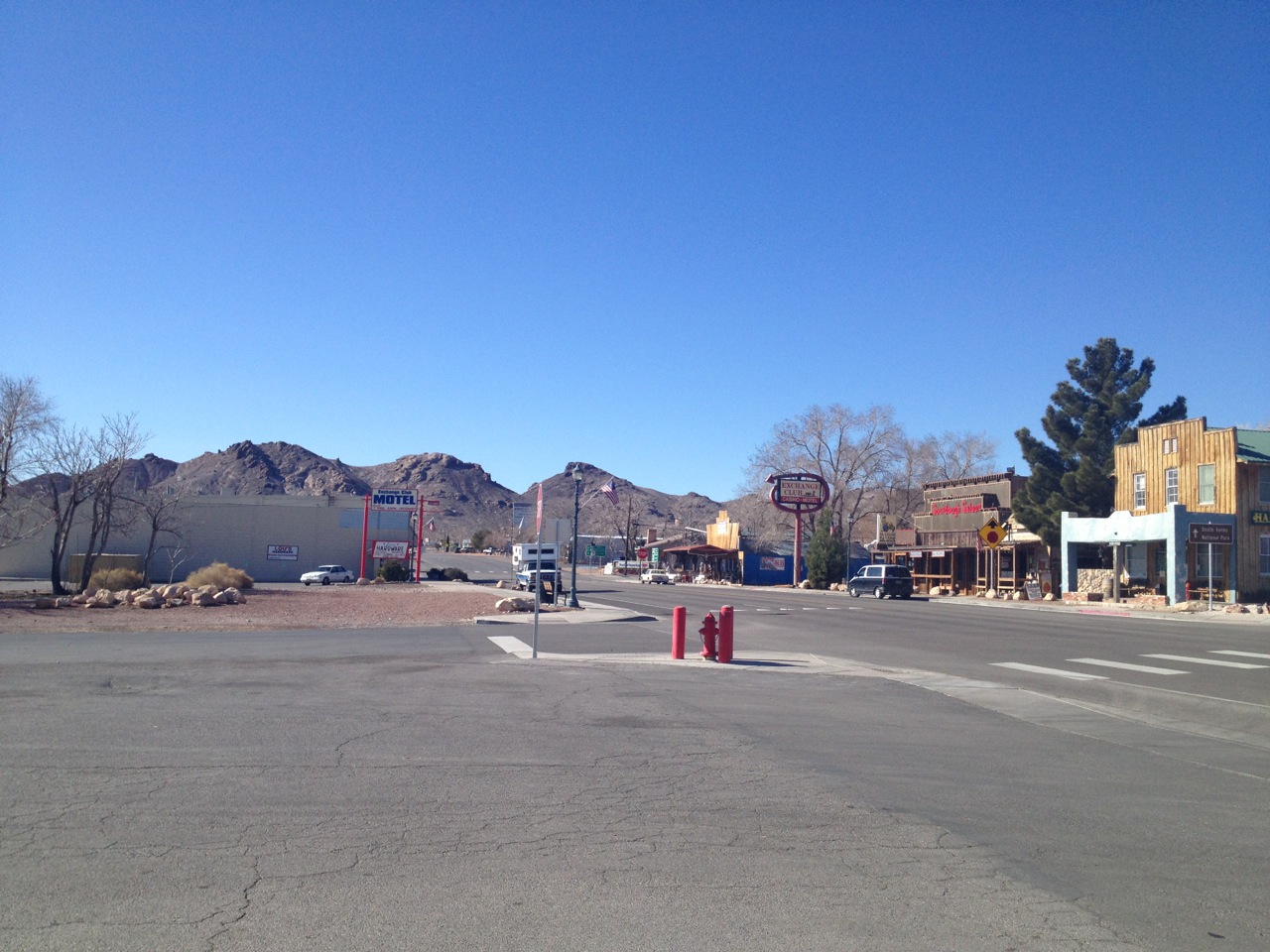
Walking up the main drag we passed what was little less than a junk yard with some rather creepy statues and a very friendly gray and white cat. One of the statues was a robot sort of fellow, but with real old running shoes stuck on its feet. They looked wilted and bleached, like they had been out in the rain and sun for too long. The other statue was a metal cast of a rearing horse, which was not so bad… except that it had the tail and mane from a real horse sewn on. I know they were real because I went up and touched them, and I could see the pieces of hide from the late horse’s neck that had been used to bolt the mane to the statue’s crest. The effect was a little unsettling.
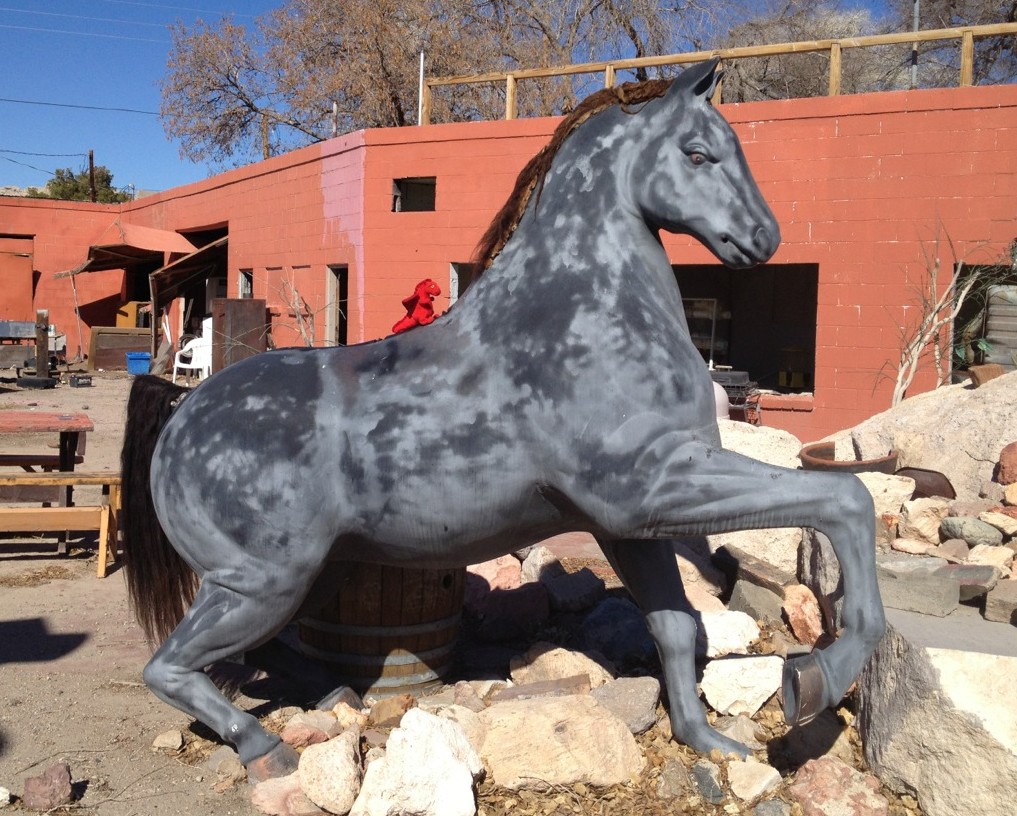
We walked up to the Beatty Historical Museum, where a very talkative docent gave us maps and pamphlets about Rhyolite (I had told her that was where we were going next), and took pictures of me and Rose in silly hats.
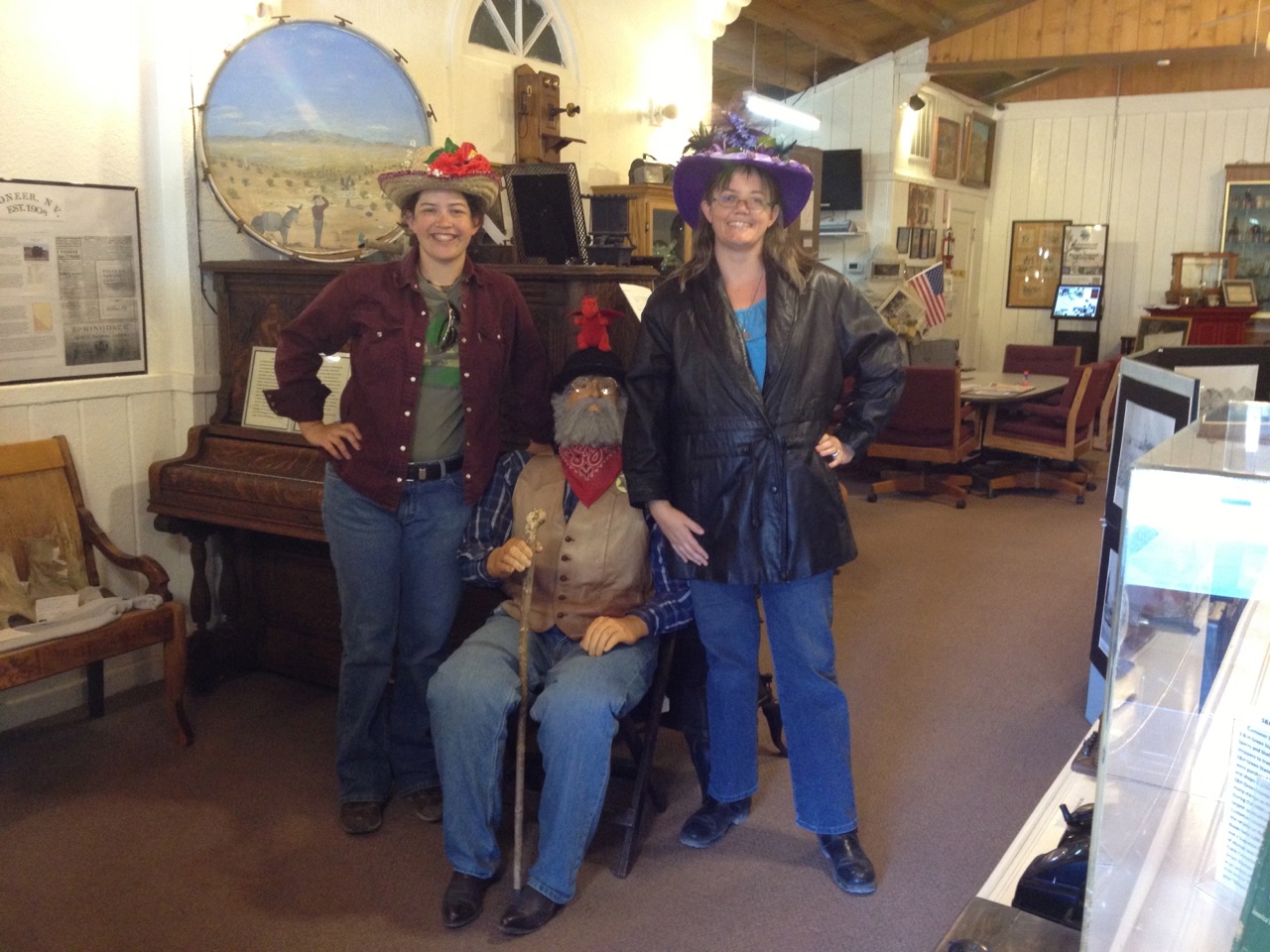
The museum itself was very interesting: it had a lot of old antiques and some very creepy mannequins—some of which looked to be hand-made. It also had a stuffed wolf and bear. The bear was made to be standing up and snarling, but the wolf was posed normally. I don’t know whether it was the taxidermist’s intention or my natural aversion to the whole thing, but I couldn’t help thinking that the wolf looked rather sad.
I had thought about stopping for lunch in Beatty, but after putting my head in the two nearest saloons and finding them too full of country music and cigarette smoke, we opted for the little coffee house across the street.
I liked it at once. As we walked in I saw at once that it was made up to be a sort of casual lounge-y sort of place, with little tables by the windows and a large, low, glass-topped table surrounded by comfortable armchairs in front of a disused fireplace. There were stuffed animals and memorabilia on the walls, and a Wii sitting on top of a VCR on the mantle piece.
A plump girl in an apron jumped up from the couch as we entered. I asked her if she had any pastries without wheat, for Rose. She explained she hadn’t, since she would be “closing in two days.” I didn’t ask what that meant, and ordered a muffin and a cup of tea. Rose ordered a sort of milkshake.
While we sat and ate, a few more customers came in (it had been completely empty). One appeared to be a regular, and he teased the full story out of the girl:
It came out that she was closing sort-of for good. It wasn’t that she was going out of business; business was good, but the owners of the property had reneged on their agreement to sell it to her cheap, and were doubling the price. After putting several thousand dollars of her own money into the property itself (not the business) she refused to keep the shop and “make it look pretty”, while they tried to sell it to someone who would kick her out. She was understandably upset, but took it with good spirit: “I’m only twenty-two,” she said. “I’ll outlive them.”
I think she is the sort of person who doesn’t need or expect any help from the universe. I imagine she has quite a life in front of her.
I’m sorry her little shop is closing; I liked it. Perhaps I will be able to immortalize it in a story some day.
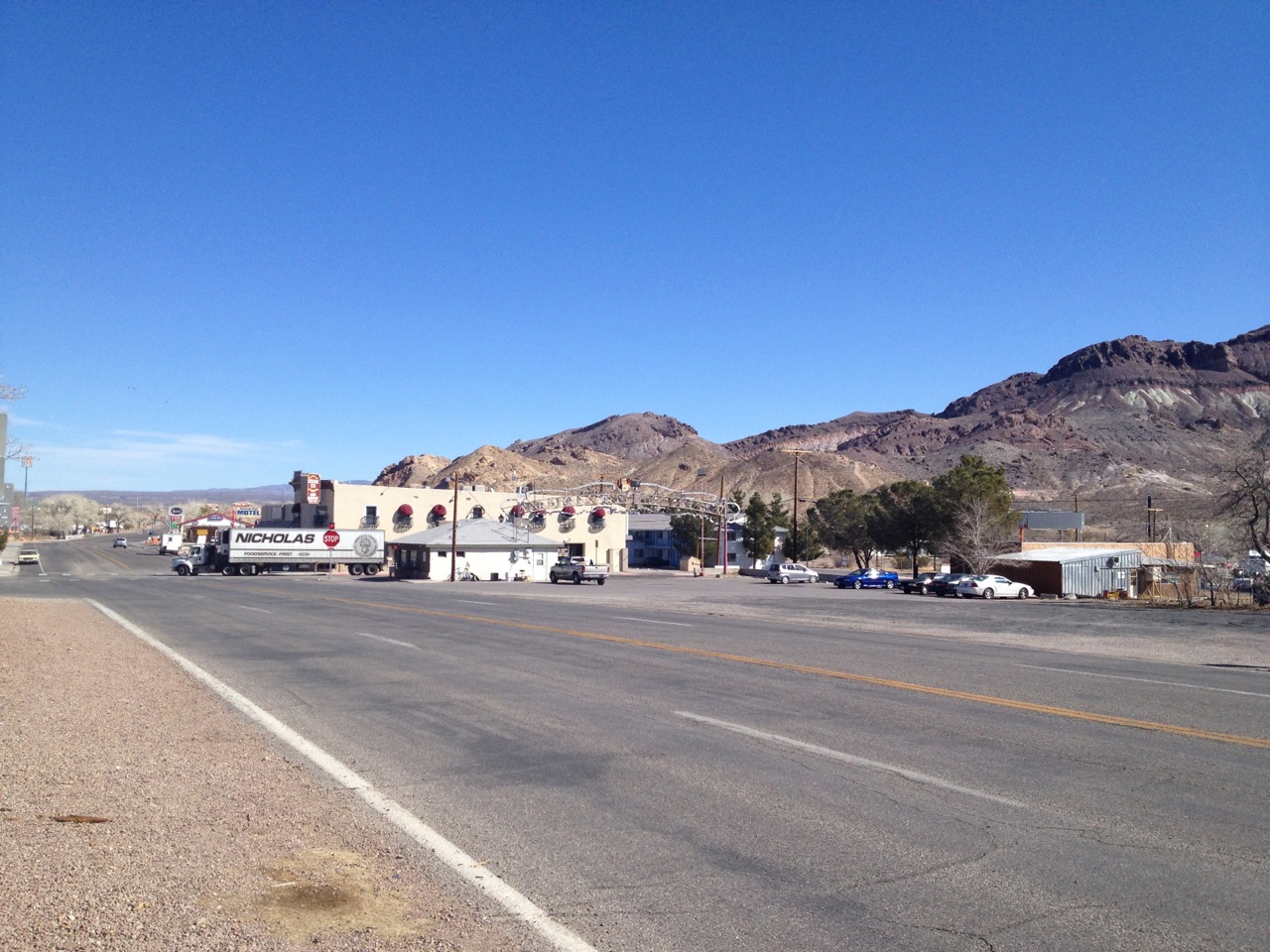
After the coffee shop, we drove back to Rhyolite. The lady at the museum had given me a map and an informational pamphlet, but I hadn’t read it. I did take out the map, which seemed to show the cemetery on the way to the town.
It turned out the cemetery was down a gravel road off an offshoot of the offshoot that led to Rhyolite. I was not eager to take the TARDIS down yet another bumpy gravel road, and so we continued on until the pavement ended. Here we found a few ruins and an old red barn with a bold “No Trespassing” sign on the door. It was otherwise deserted.
After climbing around on the ruins for a few minutes, I became aware of a faint hooting, humming sort of noise, buried deep in the pervasive gusting of the wind. This wind blew strongly out of the south the entire time we were at Rhyolite, and at this point it was blowing up the gentle slope towards the barn. Looking that way I saw there was a fence made of—not chicken wire, but the sort with bigger, square holes. It looked like there was something hung all over that fence that glinted in the light and made a faint chiming noise.
All at once I realized what I was seeing—and hearing: bottles.
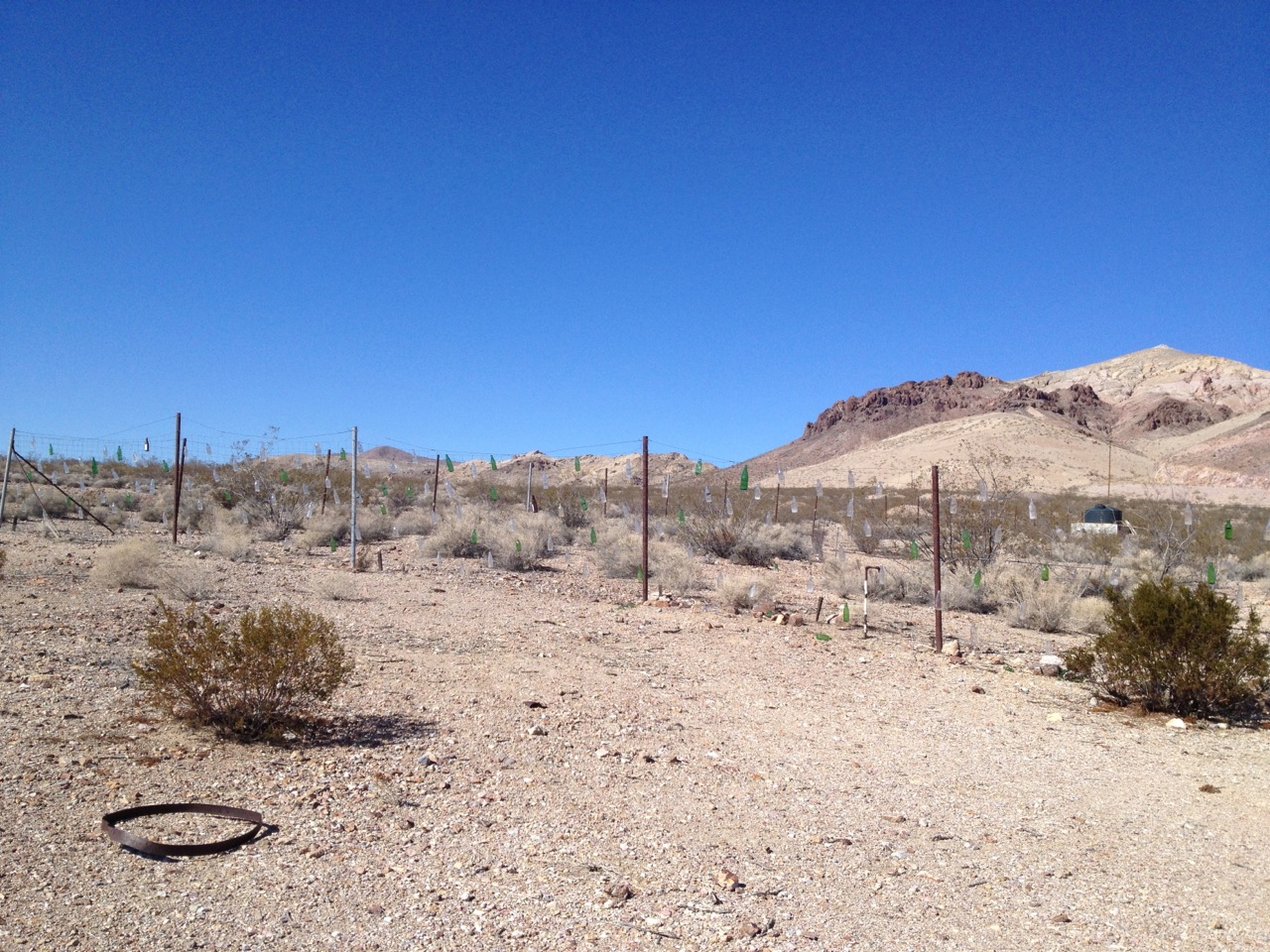
Dozens of empty glass bottles had been strung from the fence, and the wind was playing them like so many flutes. The chiming I was hearing was caused by the bottles, jostling in that same wind, clinking against the wire.
Entranced, I walked over. It was an amazing sight: the bottles were all different sizes, but they were all glass. Some were green, a couple brown. Mostly they were clear. They were arranged neatly in a square tile formation, with a few empty spaces where bottles had broken and fallen away. The ground by the fence was littered with broken glass from these bottles.
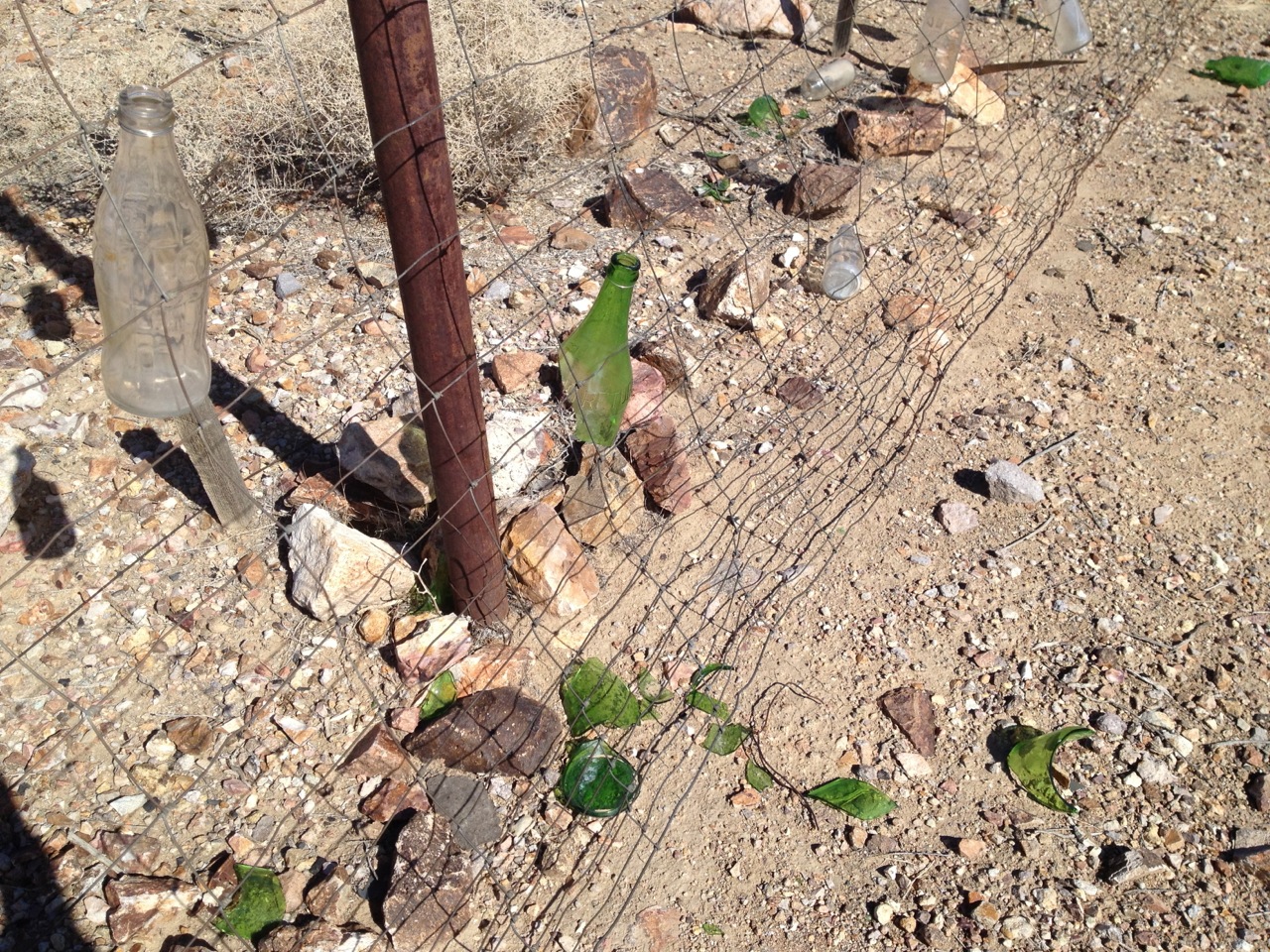
Standing right next to the fence, the hooting was louder, and the chiming came from all up and down the fence in waves as the wind fluctuated and played upon the bottles. Mixed with the buffeting roar of the wind, it almost sounded like some mad kind of orchestra. The wind also muted the sounds from the bottles so that, if I detached my mind from reality just a bit, it sounded as though there was a conversation being held in a musical language, somewhere in the distance and very close at the same time.
Rose got bored I’m afraid and went back to the car, but I had to stand there for several minutes, soaking it all in.
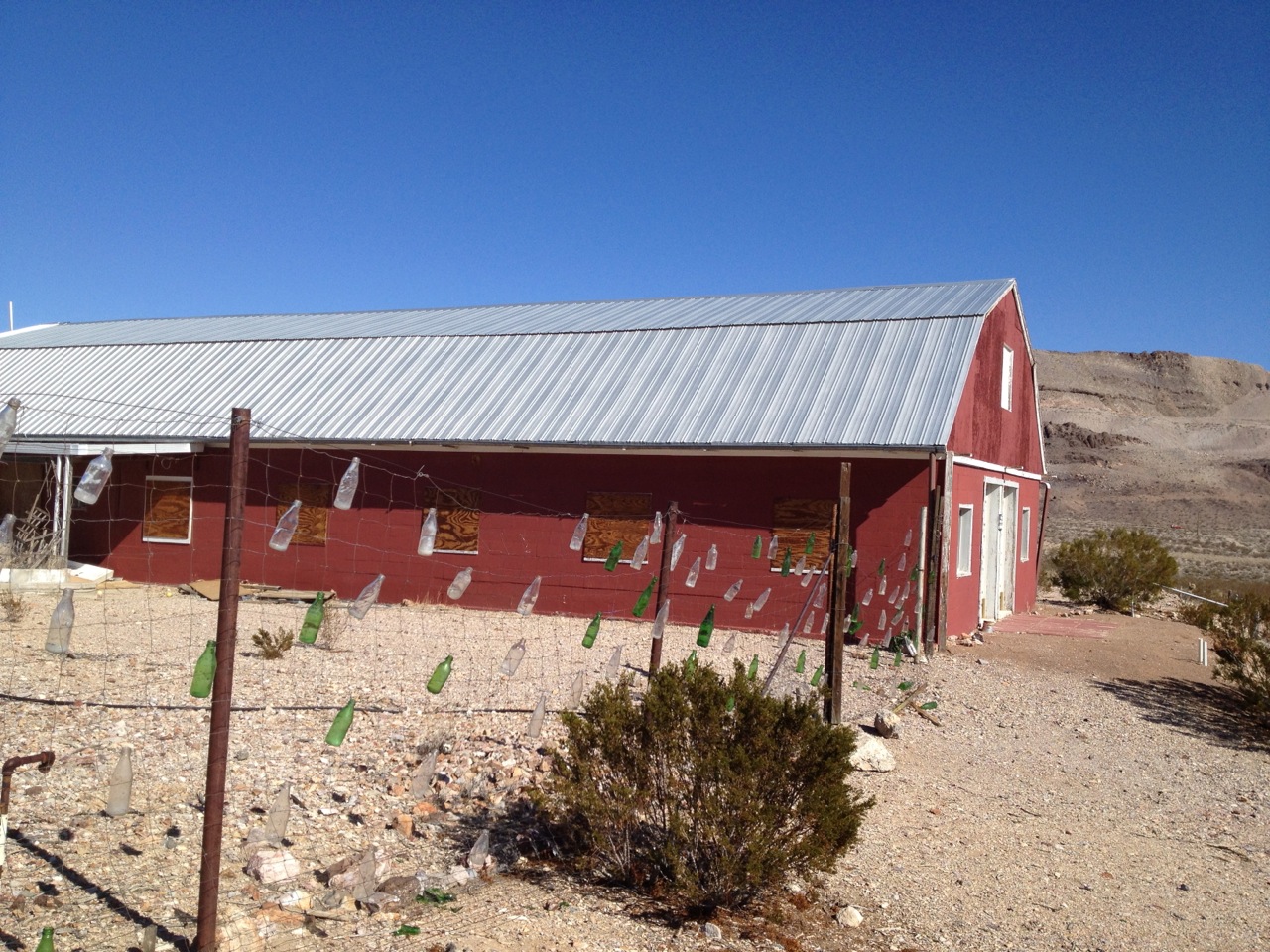
After that I was almost afraid Rhyolite would be a disappointment, but it wasn’t. The ruins are spectacular: skeletal, and built of the same pale salmon stones as the mountains around them, they are at the same time striking and camouflaged.
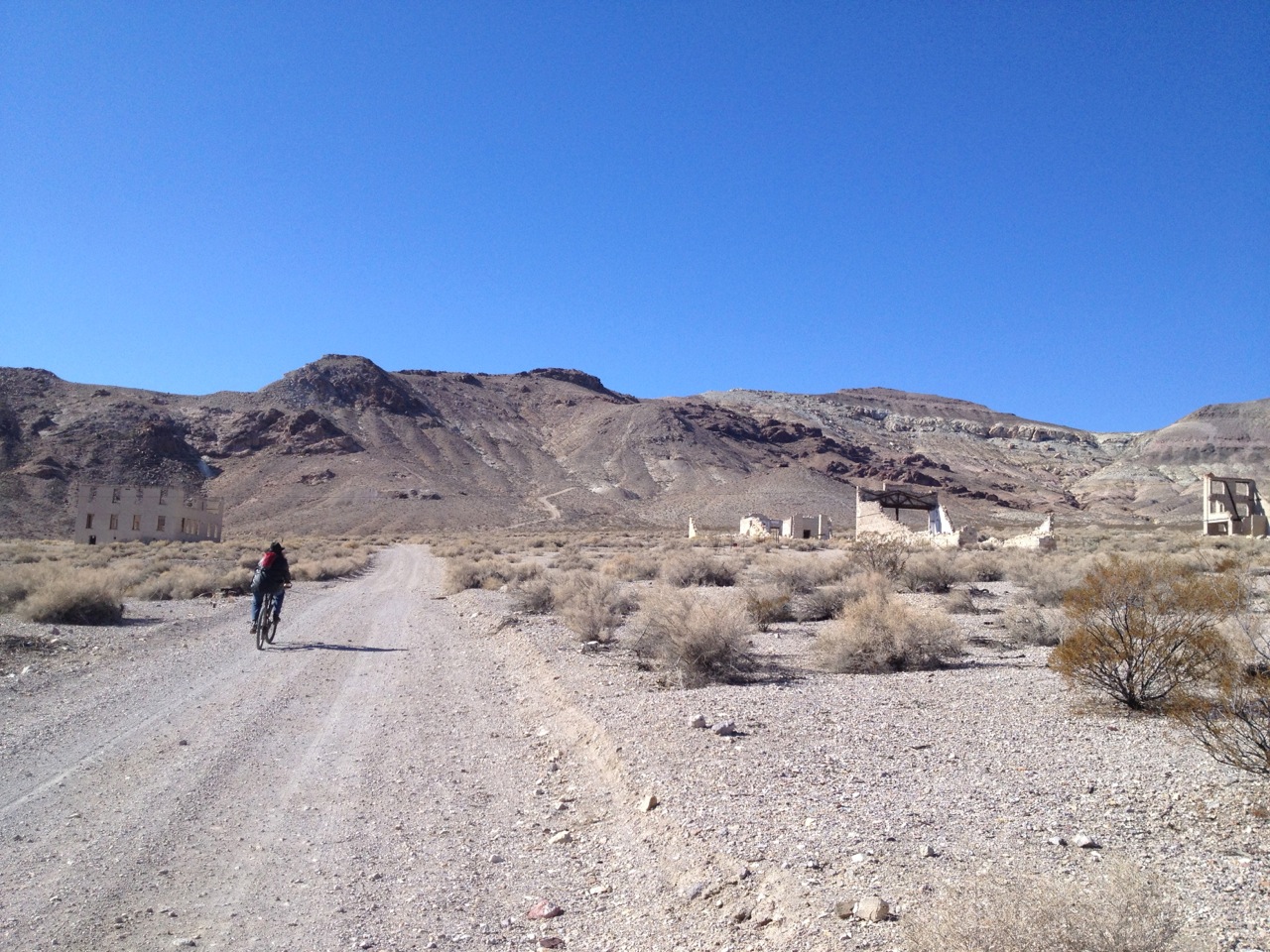
The town is built on the slope of a hill, and the main road runs up to the top where the pavement ends, and a network of dirt tracks begin. At the summit is a wide lot for tour buses and campers to turn around in, with bathrooms at the end, and at the tip of the pavement is what remains of the town’s casino.
Unlike all the other buildings, this one is muted gray with weathered green trim. The windows are boarded up, and there is an unfriendly chain link fence topped with barbed wire all around it. A sign by the locked gate warns tourists that the site contains materials that may be hazardous to their health.
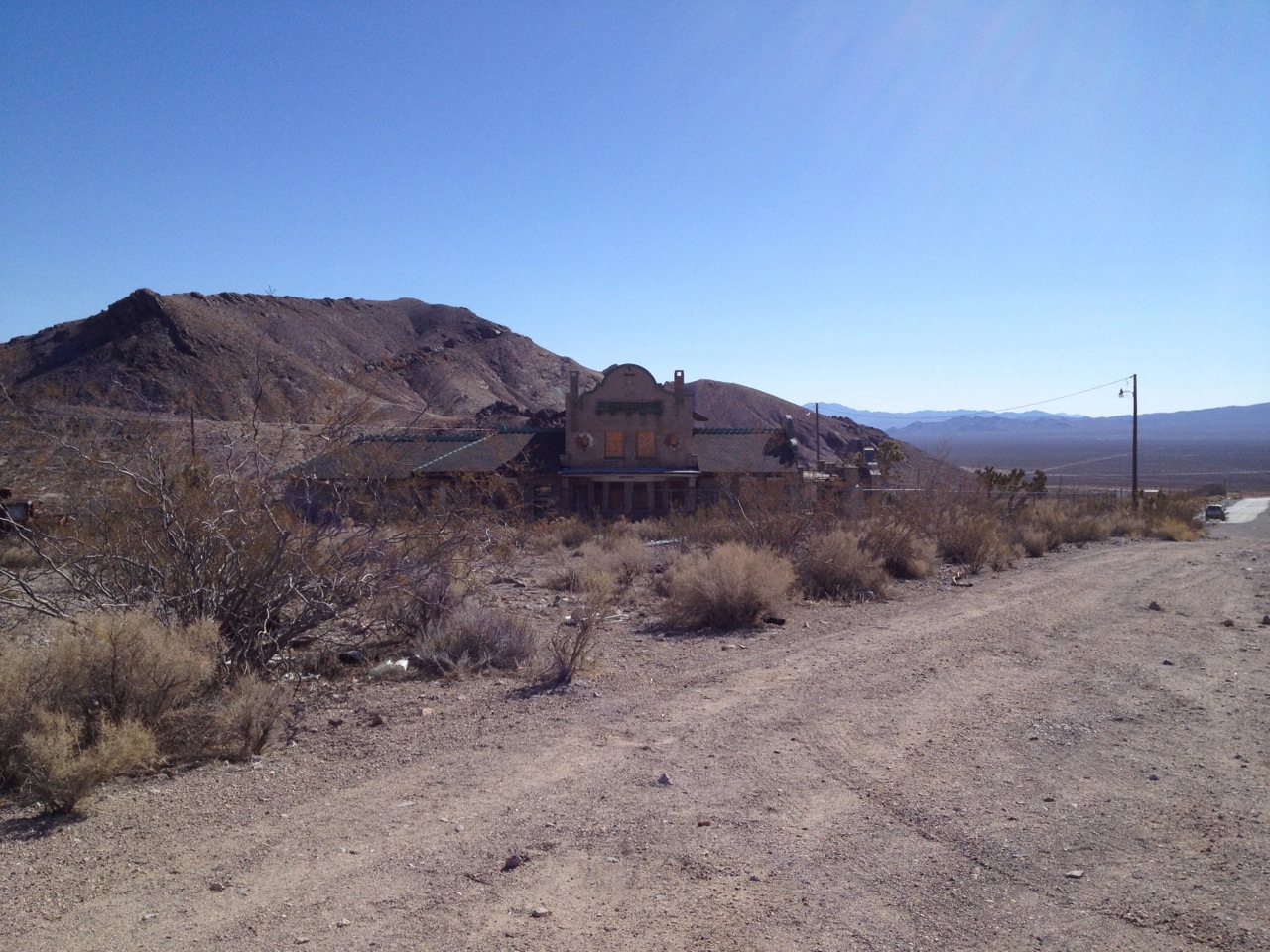
Rose and I agree that it is probably haunted.
Opposite the casino is an abandoned railway caboose. I had already climbed inside it before I found the sign (tacked to the back) asking that I please not enter. Oops.
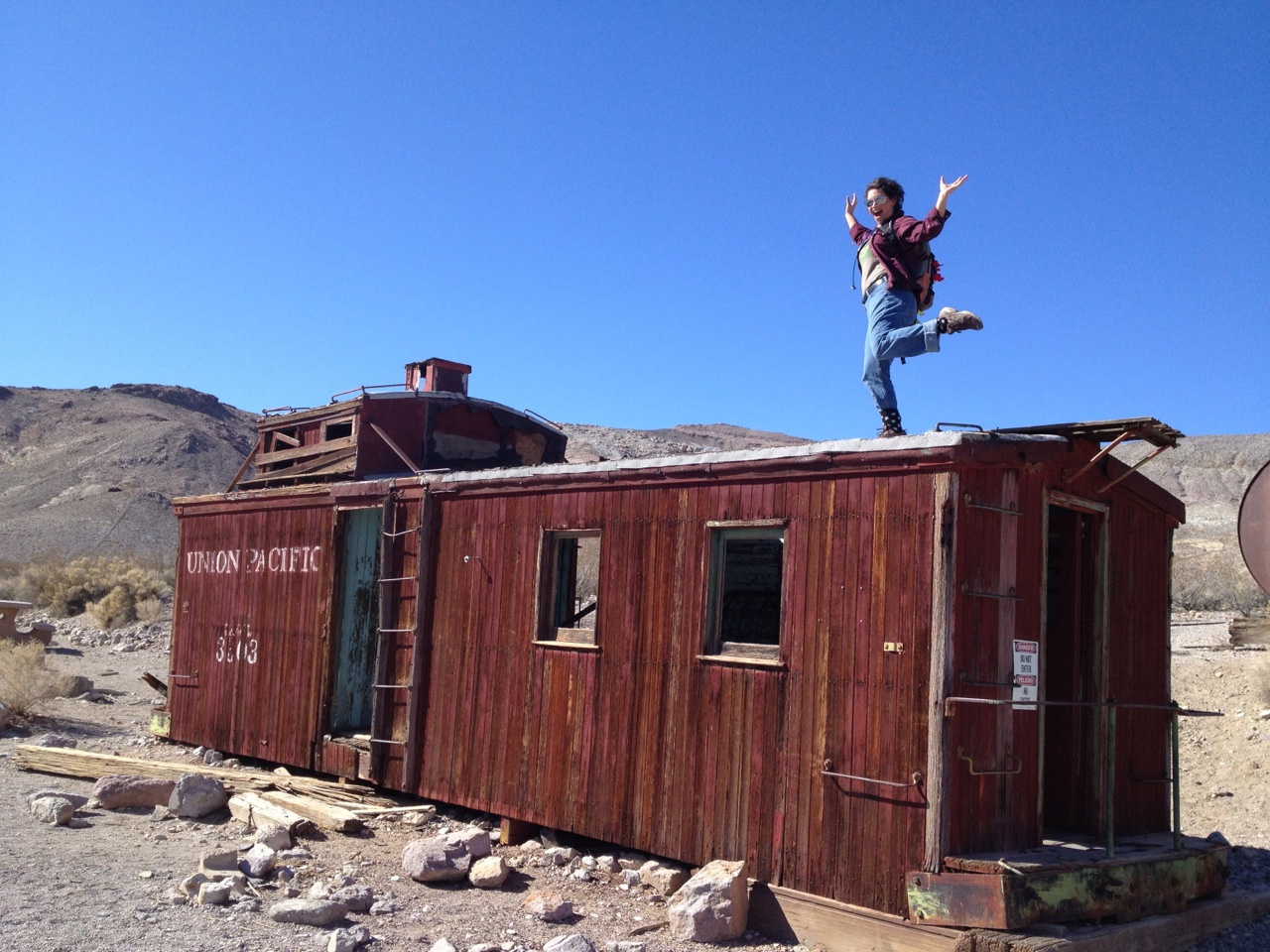
I suggested we leave the TARDIS at the top of the town, and then bike down the dirt roads through the ruins to the bottom, where I would leave Rose, bike back up, get the car, and come down and collect her. This worked beautifully: we got to go off the main road and see a lot of ruins that were not fenced off. There was a two-room structure marked as “Residence” on my map, and as “Brothel” by the sign in the window. The front door was locked, but the back door was wide open. Inside the floorboards were cracked and broken, and the walls were covered with graffiti. Beside the inner door was written “IF ONLY THESE WALLS COULD TALK.” I could resist getting out my sharpie and adding “They do!” beneath it.
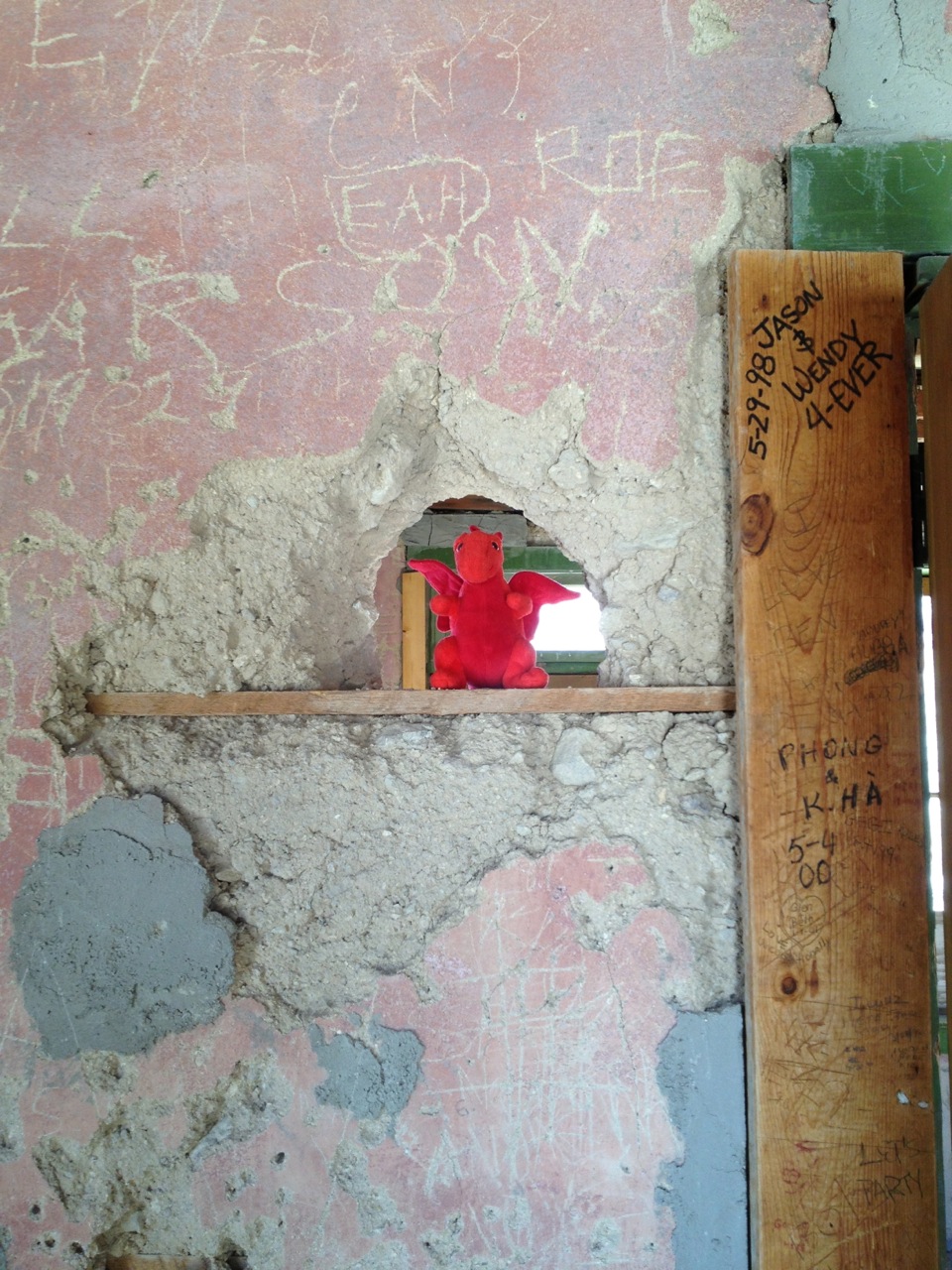
We went and saw the prison, which was half fallen down in front and filled with rubbish in the back, and then biked back to the main road where there were the remains of the general store, the jewelry store, and the bank. It was fun getting to look through the empty windows, getting to see more empty windows of other ruins through them.
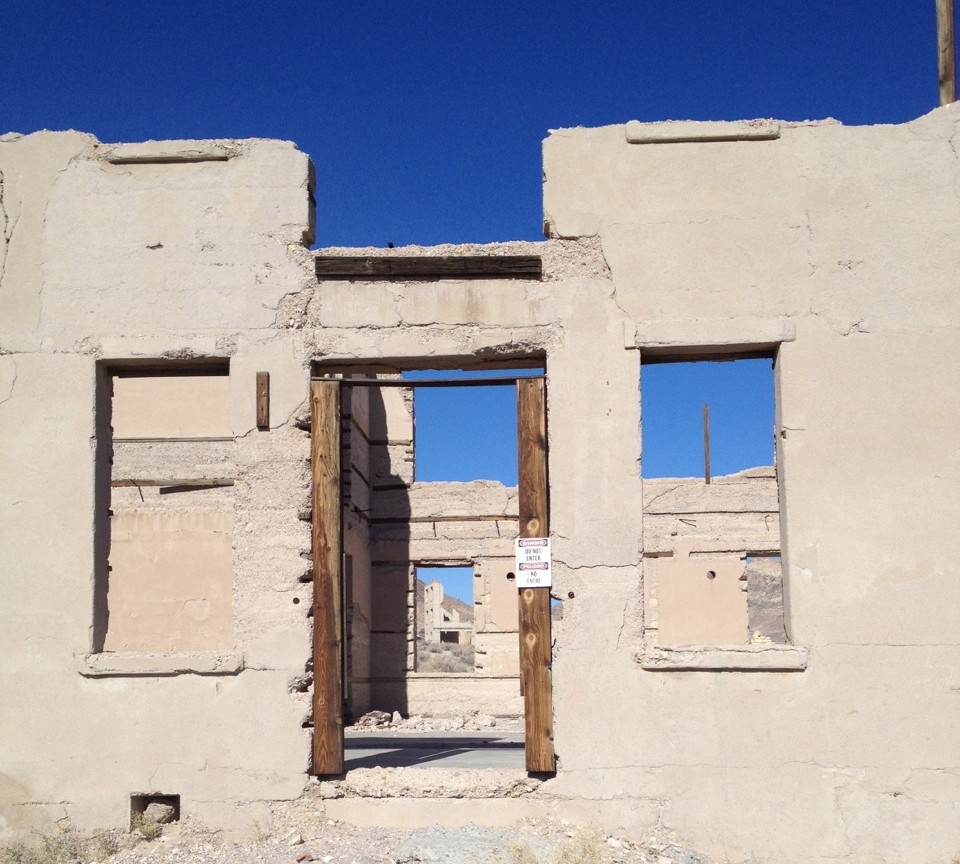
I walked around the ruins of the school, which was a fittingly monstrous building, and finally we rode down to the Bottle House.
This was a house with bottles embedded in its concrete walls. There was also a little mosaic model of a town (not Rhyolite) in the back yard. The entire affair was very beautiful, and because it was fenced off, pristine.
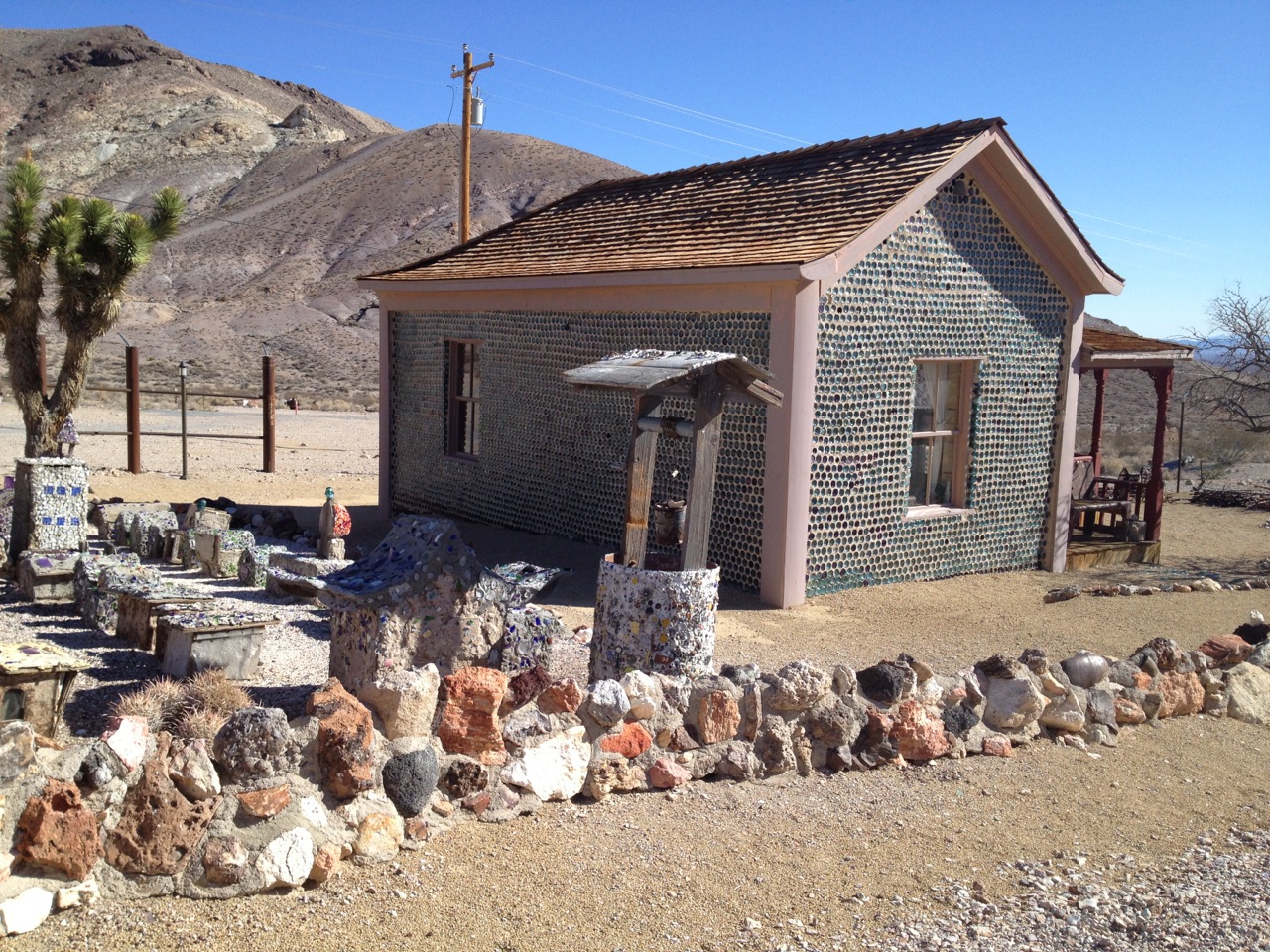
I have to admit, I did not find it as impressive as the fence with the bottles singing in the wind.
I left Rose by the bottle house and rode back up the hill to get the car.
By this time we were both getting hungry, but I determined we go see the art installation just outside the town. Here were some rather interesting statues that we took pictures of: very much Arte and not the sort of thing I would usually be interested in. But I’m glad I went. I also ran the stone spiral that had been set up, so that was fun.
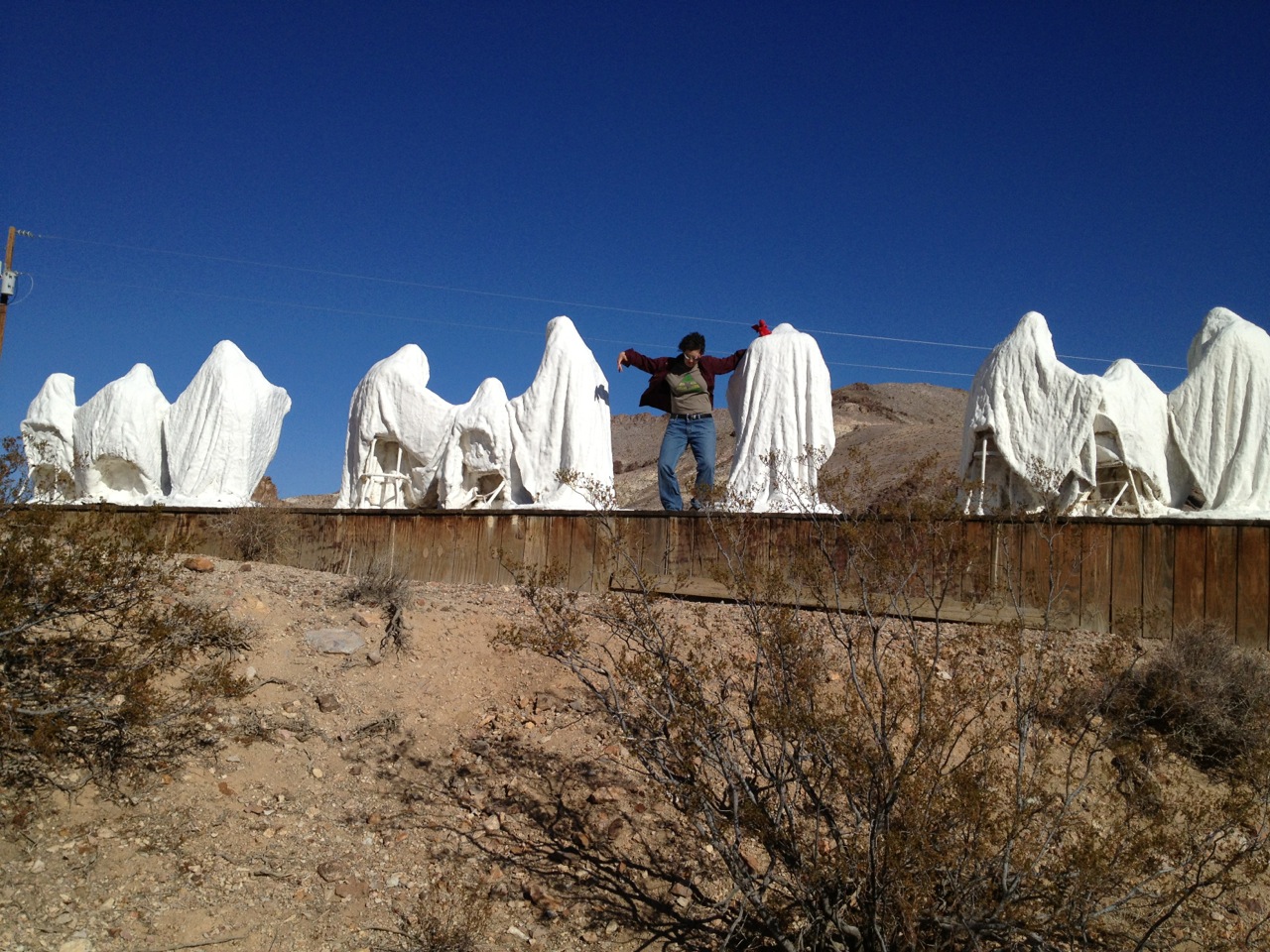
Then we went to the cemetery. Rose was happy to skip it, but I know what it’s like to go all the way for something and then miss part of it (Hi, Stanton Drew!) and I knew I wouldn’t be able to come back for a long time.
The road was bumpy, and the cemetery was not as cool as the town or the Singing Bottle Fence, but I’m glad I went and saw what it was like.
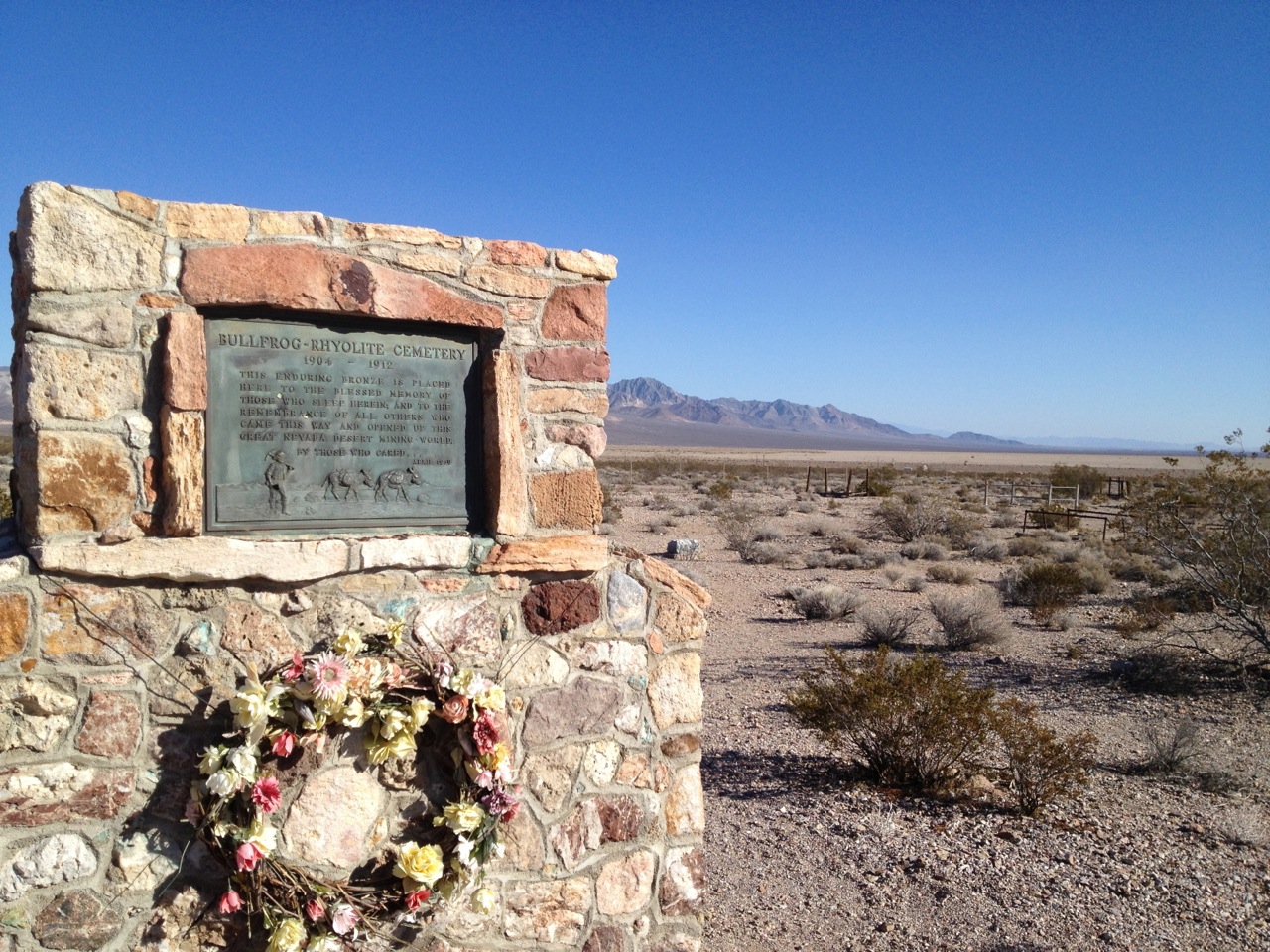
We decided to try a short cut, continuing to take the gravel road all the way to the highway. We were nearly flummoxed at the end when we encountered a rather steep dip, but having seen a couple in a Mustang do it before us, I decided the TARDIS would probably be fine. Which she was. She has been an absolute champ this trip, though she’ll need a good wash when I get home.
From Rhyolite we drove back down into Death Valley and then north some thirty-six miles to Scotty’s Castle, which is located in a steep river canyon that contains some of the few trees in the area. We ate our packed lunch on a half-dead lawn and watched the shadows creep over the Spanish-style mansion. Tours were over for the day, but we still got to walk around and take pictures.
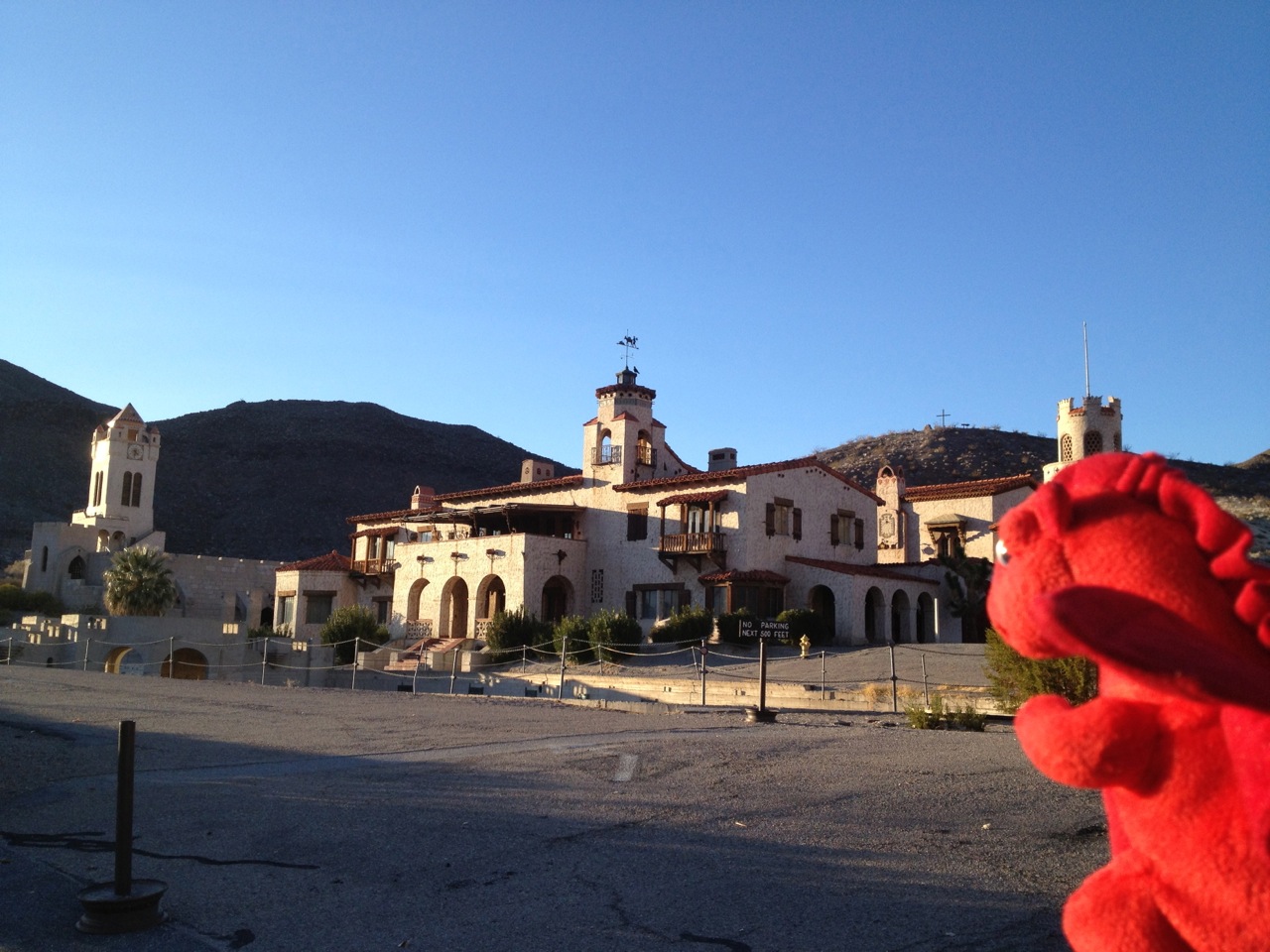
Then we drove out to Ubehebe Crater, which was less then ten miles west across the valley. Doing so we passed out of the oasis, and into a whole other sort of desert: one strewn with volcanic debris. For Ubehebe is not a meteorite crater, but a volcanic one. The hills all had a rolling, molten quality too them, black from all the volcanic ash and rock.
Driving up the narrow entrance to the parking lot, we passed the turnoff for the Racetrack, home of the famous Sailing Stones. It is twenty-five miles out a notoriously rough, rocky road. Rose says that if she ever gets an SUV, we will go see them.
The sun had set by the time we reached the crater, casting everything into a blue twilight. I parked the car, and Rose opened her door—only to pull it shut again against the wind that tore into the car. Now we looked and saw the bushes that lined the rim of the crater being blown practically side ways.
After stuffing all the loose papers into the glove compartment, we got out into the wind.
How shall I describe such wind? Perhaps I can say this: that I have not felt such force exerted upon my person in such a direct way since I last found myself braced against whitewater. I had to lean into it to prevent myself being blown over, and I gripped my phone tightly to prevent it being ripped from my hands. It blew so hard I had trouble breathing when I faced directly into it.
Fortunately, it blew out of the crater, and so I was able to creep to the edge for a better view (and pictures!) But you can understand why most of what I remember is the wind pounding into and stretching my skin. The crater was quite impressive: huge and wide and very deep, with heavily eroded sandstone cliffs leading down to a sandy bottom dotted with creosote bushes.
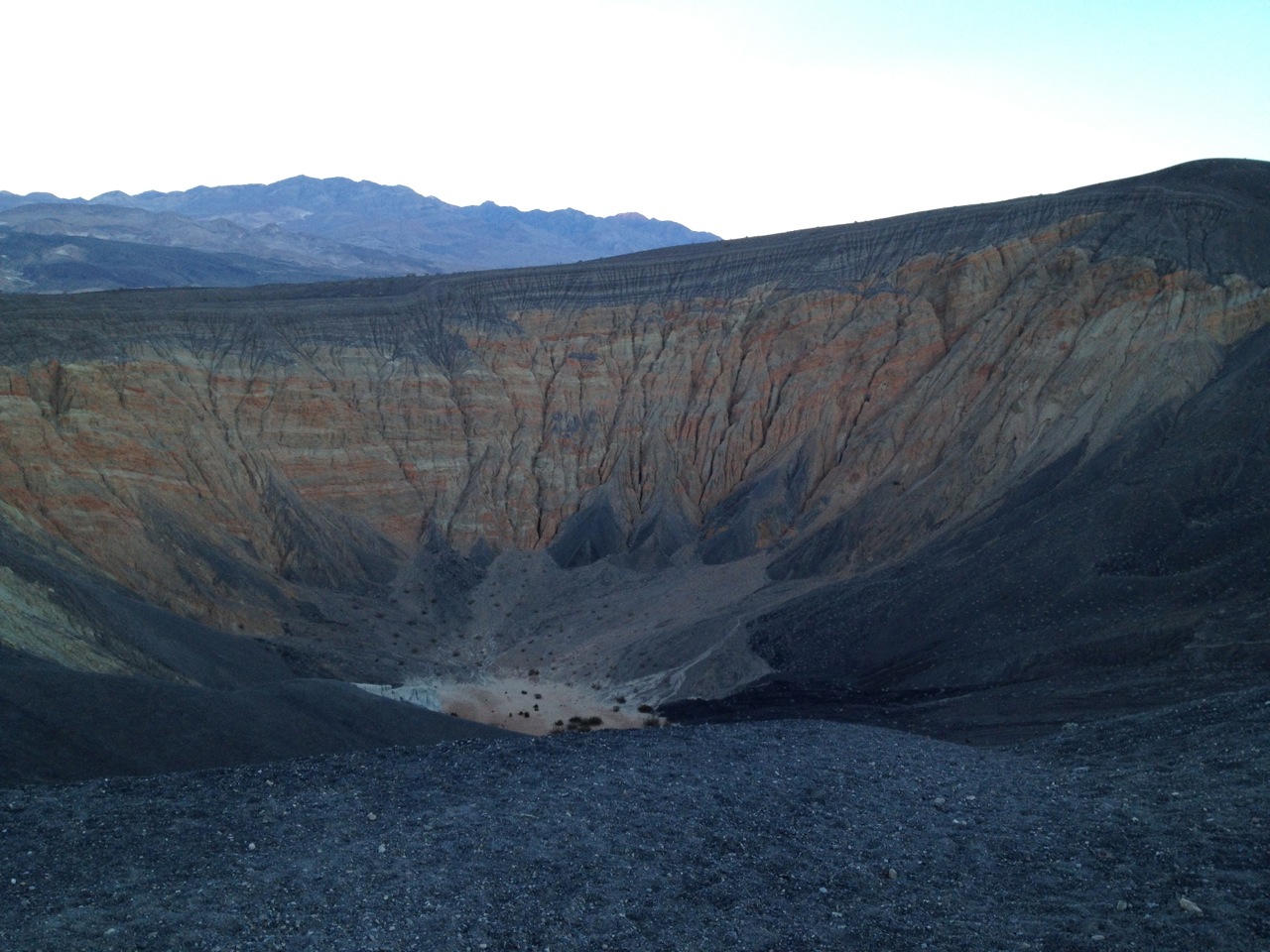
The landscape to the northwest was also impressive: a wide valley strewn with black flecks of rock and sand, with the distant mountains blue silhouettes against a pink sky, streaked with clouds.
After a few minutes in the wind I got used to it, and even performed experiments; seeing how far forward I could lean, letting the wind support my body; or jumping from the curb and feeling the wind blow me a few feet before I hit the ground. Rose waited patiently in the car until I was done.
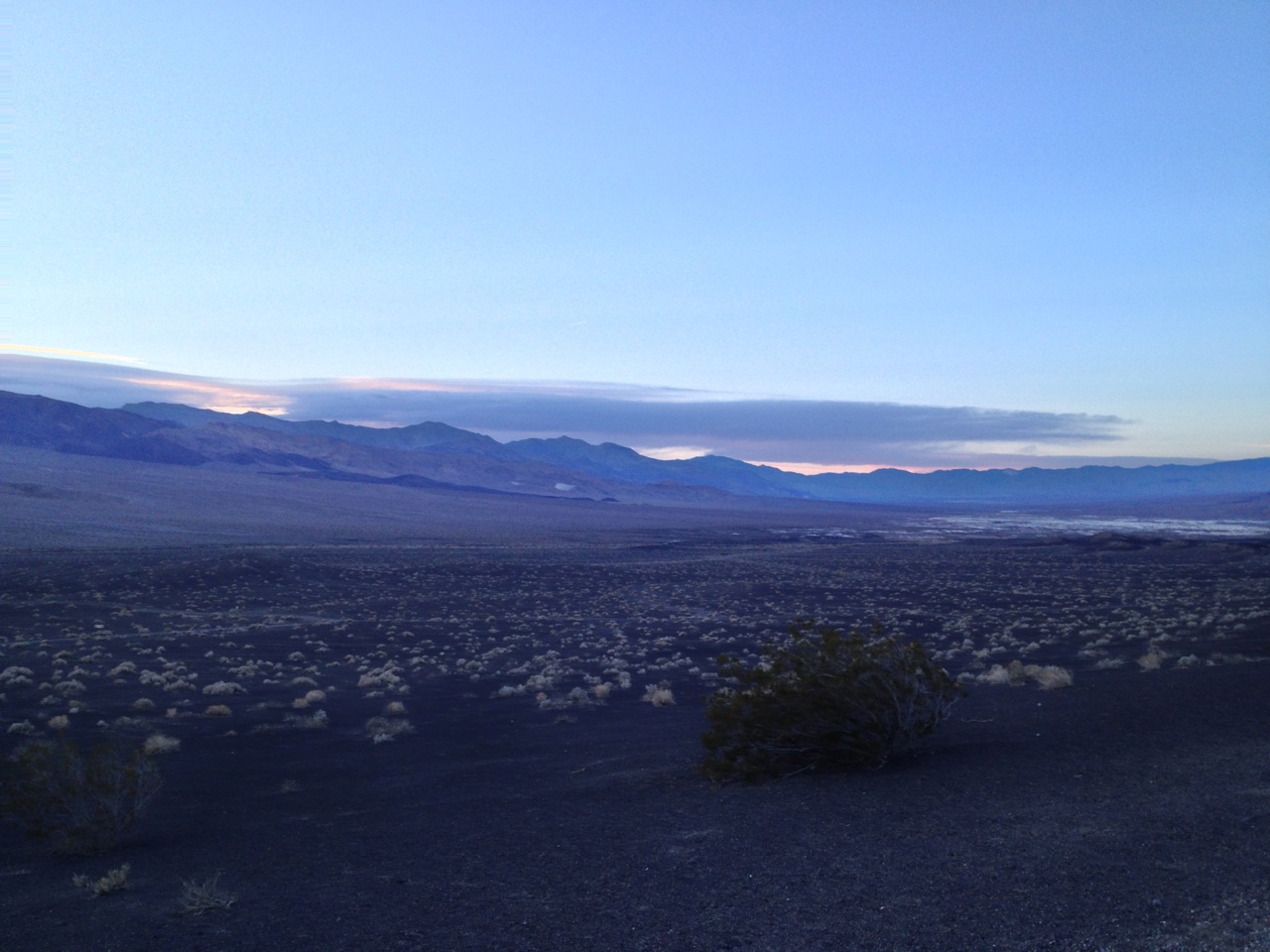
We drove the forty-five miles back to Stovepipe in growing darkness, where Rose cooked dinner and I sketched Year of the God-Fox.
Tomorrow we leave first thing, so Rose can get home in time to meet her son as he gets home from school, so this is essentially the close of my Death Valley trip.
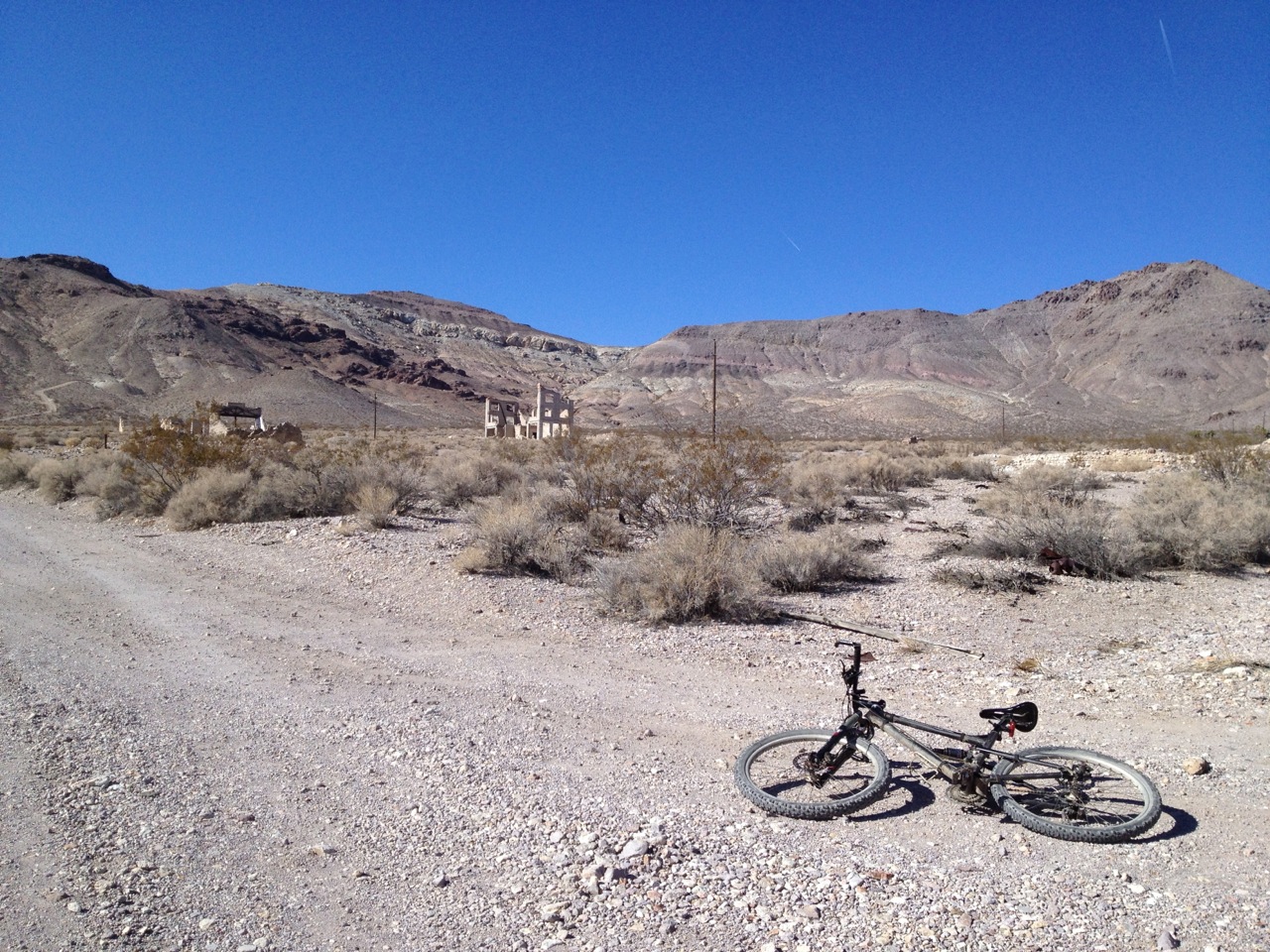
I have lots of material to work with, and lots of photos to sort through, but I also have ideas for things I’d still like to do.
I’d like to see the Sailing Stones, of course. And I’d like to go back to Ubehebe Crater when there is more time and actually hike around it. I would like to bike down Titus Canyon. And I feel I really should visit Badwater. It is the lowest point in the United States and probably the thing most people think of when you say “Death Valley.”
~G
2.7.2013
Goldeen Ogawa is an avid mountain biker, equestrian, whitewater guide, and all-around outdoorsy person who also writes stories and draws pictures. This week, she has been posting notes from her trip to Death Valley National Park. You can email her about the things in your head at goldeenogawa@gmail.com or peck at her on Twitter @GrimbyTweets.


























